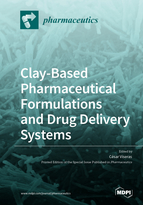Clay-Based Pharmaceutical Formulations and Drug Delivery Systems
A special issue of Pharmaceutics (ISSN 1999-4923). This special issue belongs to the section "Physical Pharmacy and Formulation".
Deadline for manuscript submissions: closed (20 August 2020) | Viewed by 32936
Special Issue Editor
Interests: medicinal products; medical devices; pharmaceutical technology; drug delivery
Special Issues, Collections and Topics in MDPI journals
Special Issue Information
Dear Colleagues,
The use of minerals as ingredients of health care products is a classical and active pharmaceutical subject. Clays, but also zeolites and other silica-based mesoporous inorganic ingredients, have been traditionally used as pharmaceutical and cosmetic ingredients. These inorganic ingredients should be able to be used as ingredients of health care products in accordance with quality and safety standards. Recently, new and advanced applications of these materials have been proposed, including design of modified drug delivery systems and other advanced applications (such as wound healing formulations and tissue engineering scaffolds). The aim of this Special Issue is to highlight the most recent advances in all aspects relevant to clay-based formulations and clay-based drug delivery systems. Natural, modified, and synthetic clays with interest in nanomedicine and pharmaceutics will be considered in this Special Issue.
Prof. Dr. César Viseras
Guest Editor
Manuscript Submission Information
Manuscripts should be submitted online at www.mdpi.com by registering and logging in to this website. Once you are registered, click here to go to the submission form. Manuscripts can be submitted until the deadline. All submissions that pass pre-check are peer-reviewed. Accepted papers will be published continuously in the journal (as soon as accepted) and will be listed together on the special issue website. Research articles, review articles as well as short communications are invited. For planned papers, a title and short abstract (about 100 words) can be sent to the Editorial Office for announcement on this website.
Submitted manuscripts should not have been published previously, nor be under consideration for publication elsewhere (except conference proceedings papers). All manuscripts are thoroughly refereed through a single-blind peer-review process. A guide for authors and other relevant information for submission of manuscripts is available on the Instructions for Authors page. Pharmaceutics is an international peer-reviewed open access monthly journal published by MDPI.
Please visit the Instructions for Authors page before submitting a manuscript. The Article Processing Charge (APC) for publication in this open access journal is 2900 CHF (Swiss Francs). Submitted papers should be well formatted and use good English. Authors may use MDPI's English editing service prior to publication or during author revisions.
Keywords
- Natural and modified clays
- Mesoporous aluminosilicates
- Clay/polymer nanocomposites
- Clay-based hybrids nanosystems
- Clay-based drug delivery
- Clay-based nanocarriers
- Clay hydrogels
- Advanced clay-based formulations







